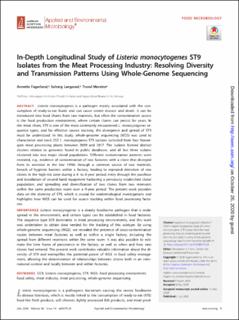| dc.contributor.author | Fagerlund, Annette | |
| dc.contributor.author | Langsrud, Solveig | |
| dc.contributor.author | Møretrø, Trond | |
| dc.date.accessioned | 2020-11-13T10:05:56Z | |
| dc.date.available | 2020-11-13T10:05:56Z | |
| dc.date.created | 2020-07-27T09:21:48Z | |
| dc.date.issued | 2020 | |
| dc.identifier.citation | Applied and Environmental Microbiology. 2020, 86 (14), . | |
| dc.identifier.issn | 0099-2240 | |
| dc.identifier.uri | https://hdl.handle.net/11250/2687746 | |
| dc.description.abstract | Listeria monocytogenes is a pathogen mostly associated with the consumption of ready-to-eat foods and can cause severe disease and death. It can be introduced into food chains from raw materials, but often the contamination source is the food production environment, where certain clones can persist for years. In the meat chain, ST9 is one of the most commonly encountered L. monocytogenes sequence types, and for effective source tracking, the divergence and spread of ST9 must be understood. In this study, whole-genome sequencing (WGS) was used to characterize and track 252 L. monocytogenes ST9 isolates collected from four Norwegian meat processing plants between 2009 and 2017. The isolates formed distinct clusters relative to genomes found in public databases, and all but three isolates clustered into two major clonal populations. Different contamination patterns were revealed, e.g., evidence of contamination of two factories with a clone that diverged from its ancestor in the late 1990s through a common source of raw materials; breach of hygienic barriers within a factory, leading to repeated detection of two clones in the high-risk zone during a 4- to 6-year period; entry through the purchase and installation of second-hand equipment harboring a previously established clonal population; and spreading and diversification of two clones from two reservoirs within the same production room over a 9-year period. The present work provides data on the diversity of ST9, which is crucial for epidemiological investigations and highlights how WGS can be used for source tracking within food processing factories | |
| dc.language.iso | eng | |
| dc.subject | CC9 | |
| dc.subject | CC9 | |
| dc.subject | Listeria monocytogenes | |
| dc.subject | Listeria monocytogenes | |
| dc.subject | Mattrygghet | |
| dc.subject | Food safety | |
| dc.title | In-Depth Longitudinal Study of Listeria monocytogenes ST9 Isolates from the Meat Processing Industry: Resolving Diversity and Transmission Patterns Using Whole-Genome Sequencing | |
| dc.type | Peer reviewed | |
| dc.type | Journal article | |
| dc.description.version | publishedVersion | |
| dc.source.pagenumber | 18 | |
| dc.source.volume | 86 | |
| dc.source.journal | Applied and Environmental Microbiology | |
| dc.source.issue | 14 | |
| dc.identifier.doi | 10.1128/AEM.00579-20 | |
| dc.identifier.cristin | 1820539 | |
| dc.relation.project | Nofima AS: 10015 | |
| dc.relation.project | Nofima AS: 201704 | |
| dc.relation.project | Norges forskningsråd: 207765 | |
| dc.relation.project | Norges forskningsråd: 262306 | |
| cristin.ispublished | true | |
| cristin.fulltext | original | |
| cristin.qualitycode | 2 | |
